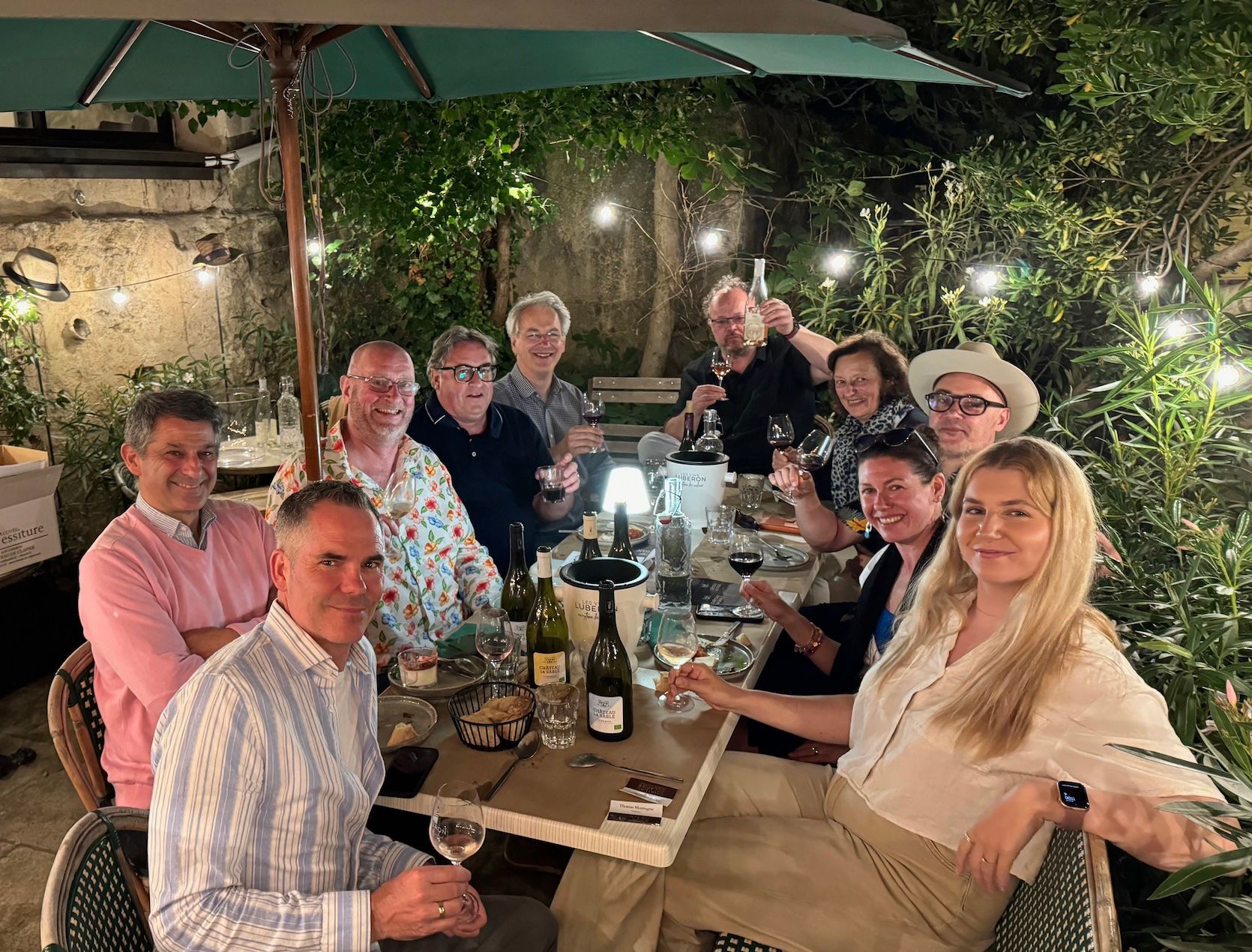No matter how many wines you taste, or producers you meet from any given wine region at a generic tasting or trade fair, nothing beats going and visiting them in person and seeing how the wines perform in the environment where they are made. The chance to experience and see the terroir for yourself. The big drops in temperature between day and night. The humidity, or the winds that the vines have to live with every day. That’s how a wine region can truly come to life.
That was very much the hope of the recent buyers’ trip organised by the Wines of Luberon and The Buyer. A chance for The Buyer to recruit key players from across the premium on and off-trades and give them the opportunity to visit a region they had not been to before and discover wines that might potentially have a bright future in the UK, but are currently still below the radar.
An opportunity for them to meet a wide selection of producers that best demonstrate some of the innovations and investments being made in the region to raise the quality of its overall wine.
Buyers’ Panel
The panel of buyers included:
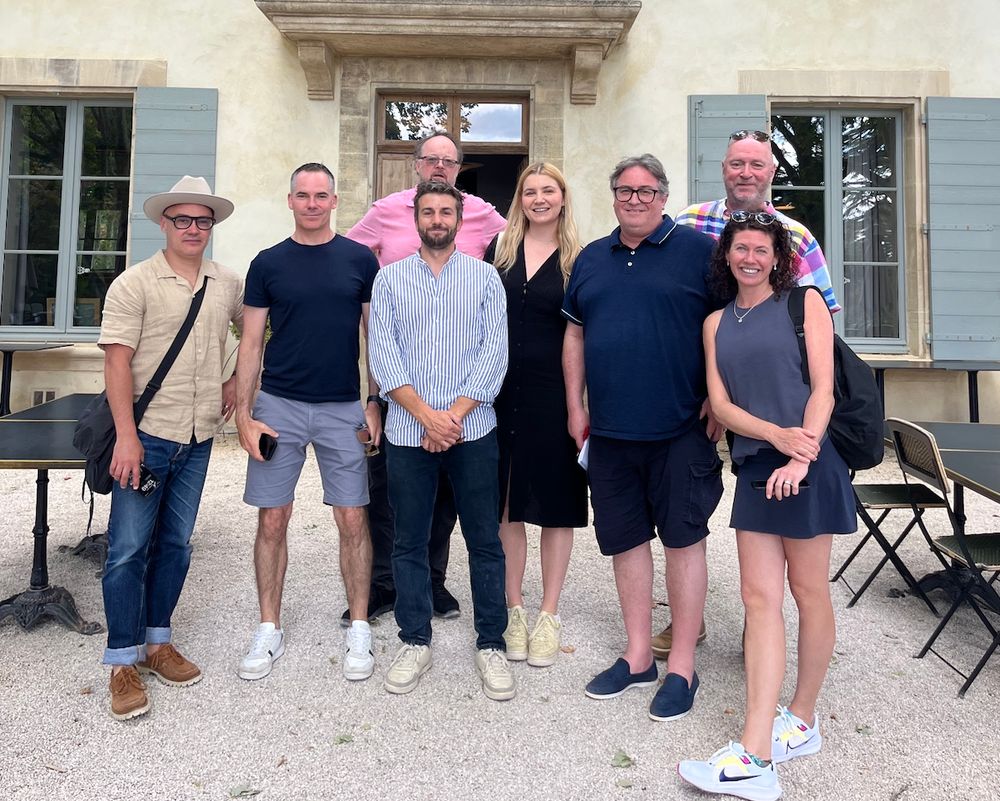
The Luberon buyers panel pictured with of. Left to right: Heath Ball, Ian Wharton, John Graves (back), Katy Wilson, Richard Siddle, Danny Spencer and Juliet Doughty
Danny Spencer, co-founder, East Street Wine Co
The vastly experienced Danny Spencer will be well known to on-trade buyers and wine merchants both for his time helping to establish Boutinot as one of the UK’s most innovative and successful wine importers and then more recently building up the reputation and distribution of his own wine importing business East Street Wines.
John Graves, business development and key accounts director at Enotria&Coe
John Graves is a key part of the Enotria&Coe wine management team helping to drive and grow its business with key customers across the premium on and off-trades. He has held a similar role at Bibendum where he was on-trade channel director and is one of the UK’s most respected figures in the wine distribution sector.
Juliet Doughty, sommelier and sales at Liberty Wines
Juliet Doughty, has recently returned to the UK from a number for years living in Canada where she worked for a number of well-known restaurants. At the time of the trip she was head sommelier at Michelin chef, Philip Howard,’s Elystan Street, in Chelsea, London. She has now moved to start a new role as part of the sales team at Liberty Wines.
Ian Wharton, head sommelier, Scott’s Richmond
Canadian Ian Wharton has been living in the UK for the last two years and heads up the sommelier and wine team at Scott’s in Richmond, sister restaurant to Scott’s in Mayfair. He has wide experience as an advanced sommelier and worked for a number of leading Canadian restaurants including Elisa Steakhouse.
Heath Ball, managing director, The Frisco Property Company, including The Red Lion & Sun
Heath Ball is one of the UK’s most innovative and influential pub operators with a small selection of award-wining pubs in London and the south east of England including the Red Lion & Sun in Highgate - sixth in the most recent Top 50 Gastro Pubs - who personally manages his highly sought after wine list that pairs wines against some of the UK’s highest quality pub food.
Katy Barker, retail and marketing manager, The Oxford Wine Company
Katy Barker has firmly established herself as a key part of the award-winning Oxford Wine Company team helping to run one of the UK’s most respected and successful wine merchants’ retail operation.
Introducing Luberon
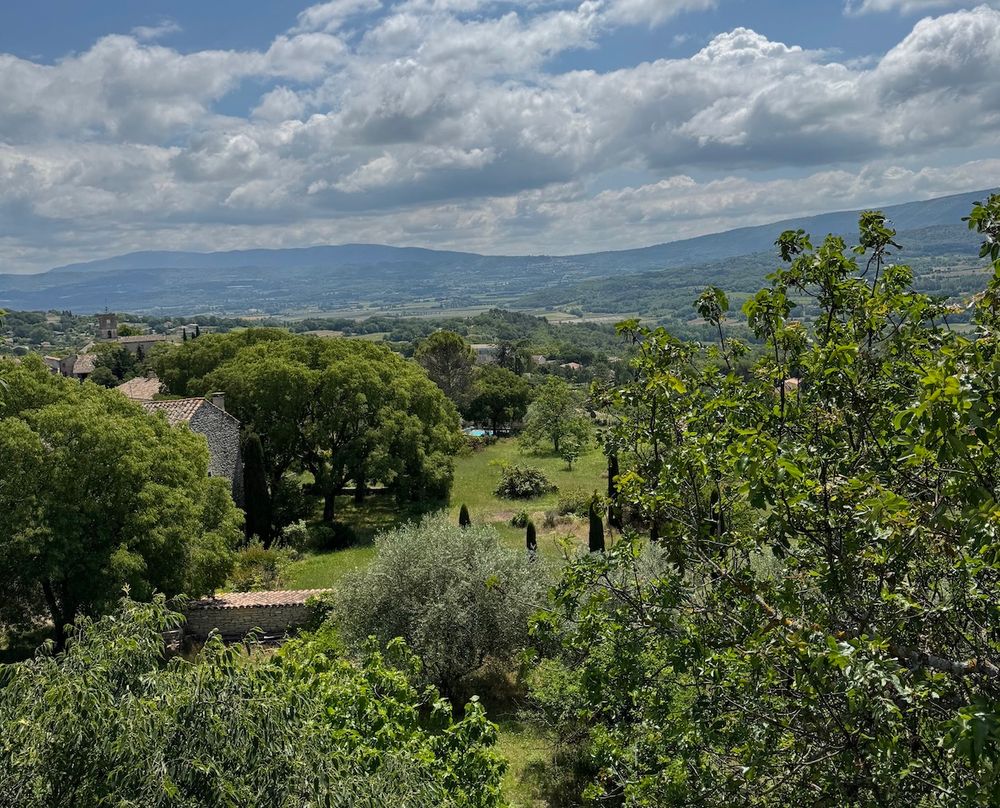
The region of Luberon has come a long way in its short history as a dedicated appellation
The official Appellation of Luberon only dates back to 1988 although vines have been planted in the region for over 2,000 years. Here are some key facts to introduce the region:
- Luberon sits in a regional natural park covering 3,000 hectares and 36 communes with a rich variety of flora and fauna, with lavender, cherry, oak and almond trees.
- A key influence on winemaking in the area is the mountain range that splits into the main wine producing areas between those in the north and the south.
- Luberon’s range of low mountains stretches from Cavaillon in the west to Manosque in the east and cover 60 kms, bordered in the south by the Durance River and to the north by Calavon River. Its summit is 1,125m high.
- A quarter of vineyards planted are in the north up to the Rhône border with the remaining three quarters towards Provence in the south.
- 95% of vineyards are planted at 300m but there are vineyards of up to 450m in the north and 600m in the south.
- Large swings in day and night conditions on both sides of the mountain range help to make wines that are fresh and full of acidity, but warm to hot temperatures during the day in the key growing months allows for smooth maturation and well coated tannins.
- Picking days vary considerably down the valley, from early in the east, in the Précoce area, to late in the west and the Tardive district.
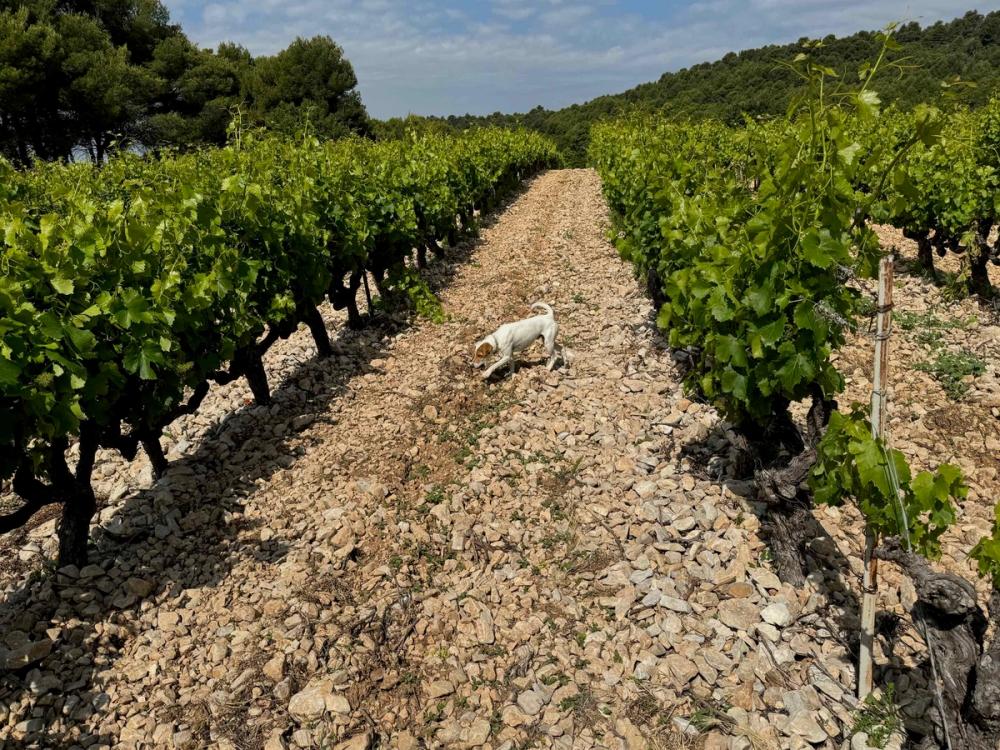
- There are four distinct soil types in the Luberon.
- Miocene sands in the ‘Pays d’Aigue’ in southern Luberon that help make light, fresh, delicate wine with fine, elegant and low in tannins.
- Limestone scree at the foot of the mountain slopes which make light, aromatic, supple and well rounded wines with good body and fruity, floral flavours.
- Clay soils in northern Luberon help make richly coloured wines, high in alcohol with powerful flavours and tannins.
- There are 12 main grape varieties:
- For reds they are: Syrah; Grenache; Mourvèdre; Carignan; and Cinsault.
- The whites are: Clairette Blanche; Vermentino; Bourboulenc; Roussanne; Marsanne; Ugni Blanc; and Viognier.
- To be an AOC wine it needs to be a blend of several varieties.
Wine Styles

The buyers had the opportunity to taste wines from across the region and its range of white, red and rosé wines - like here from Domaine Citadelle
Red AOC Luberon
These tend to be smooth, fruity and very easy on the palate with good notes of small ripe berries (blackcurrants, blackberries and raspberries). More complex styles can also be a spicy and peppery but still have elegance and freshness on the palate. The main varieties are Syrah, Grenache and Mourvèdre.
Rosé AOC Luberon
The Luberon region makes rosés that are both very pale to bring pink depending on where they are made, but both have strong notes of red fruits (strawberries and redcurrants) and freshness. The main varieties are Syrah, Grenache, Cinsault and white variety - Vermentino.
White AOC Luberon
The white lines are both lively and elegant and have strong aromas of grapefruits and peaches depending on where they are made with more complex wines offering notes of honey and toast. The main varieties are Grenache white, Vermentino, Clairette, Roussanne, Bourboulenc and Marsanne.
Key facts and figures for 2023
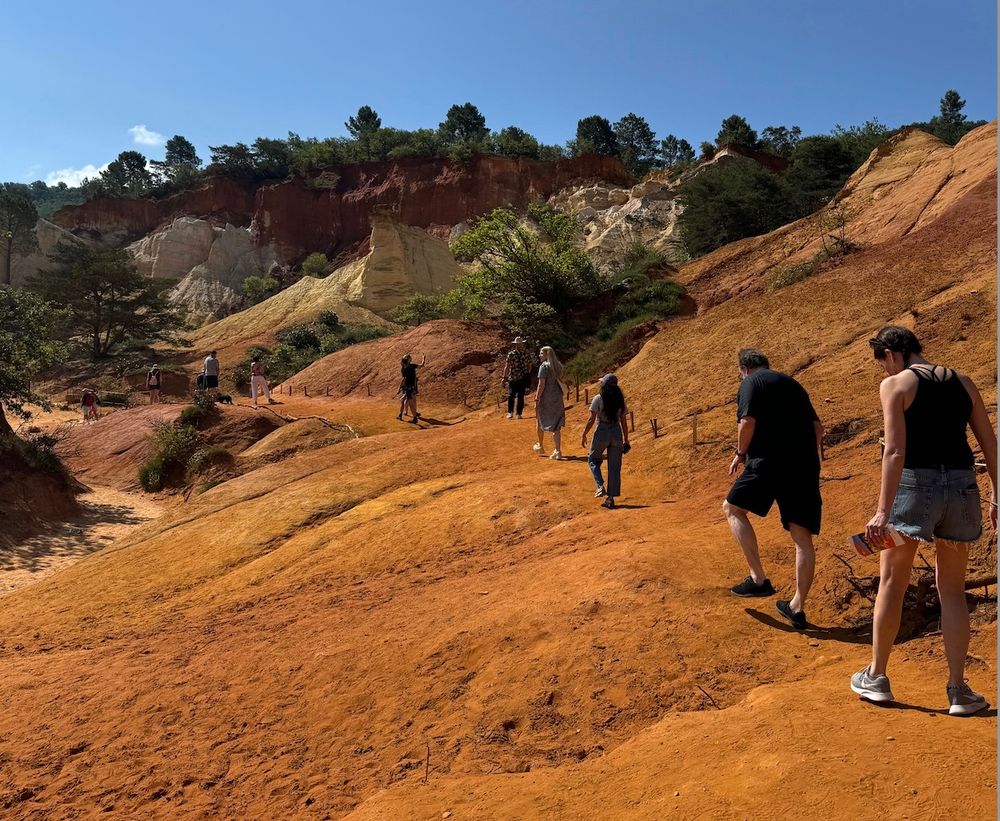
The Luberon has a mix of soil types and terroir from the north to south , east to west of the region
- Total surface area is 3,159 hectares, second in the southern Rhône area behind Ventoux.
- 25% of production is organic.
- 130,743hectolitres produced around 18m bottles.
- 41.38 hectolitre per hectare.
- White wine was 34,793hl - 27% of production
- Red wine was 32,283hl - 25% production
- Rosé wine was 63,668 hl - 48% of production.
- The Luberon region is 60km wide and 20km north to south.
- Luberon exports 24% of its wines, amounting to 34, 528 hl.
- Key export markets are Germany first with 8,632 hl, Belgium second with 7,596 hl followed by Canada, 5,870 hl and UK 4,488 hl in 2021.
- There are currently around 62 private domaines, 10 co-operatives and 13 negociants.
What the Luberon has to offer
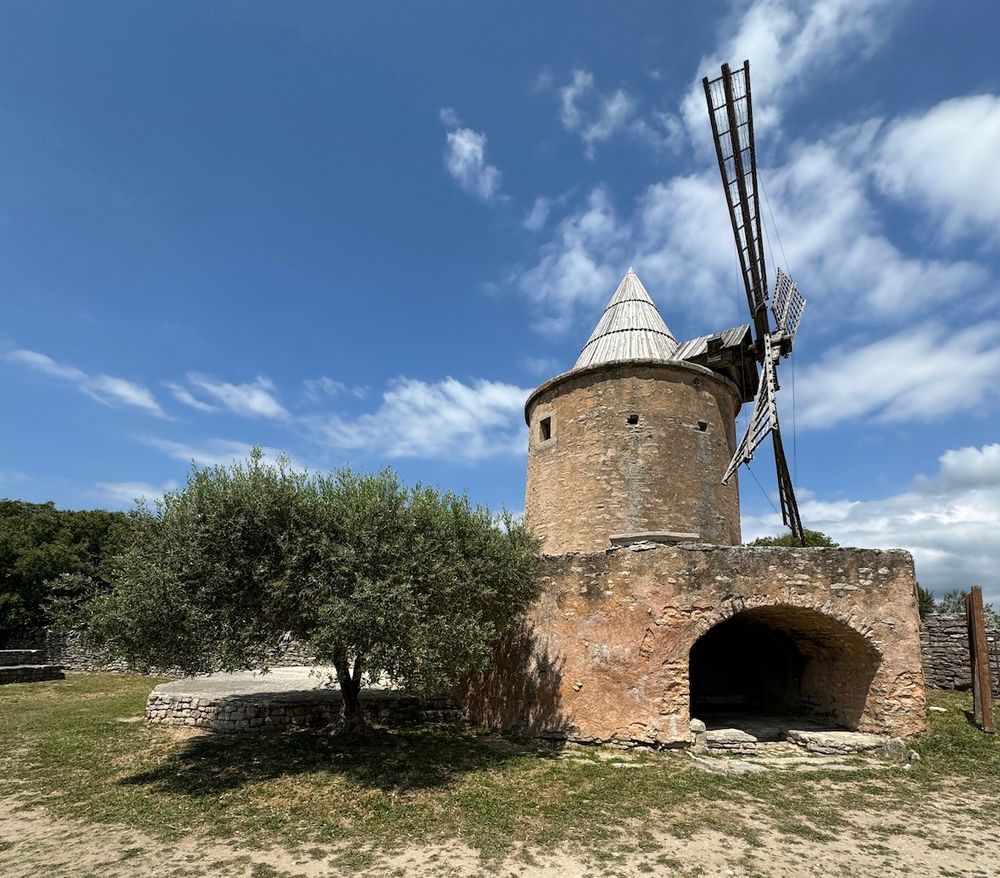
The Luberon offers stunning scenery, hillside towns and a backdrop that has attracted tourists and writers like Peter Mayle to set up home in the region
“We are Provence and Rhône’s little secret,” is how Wendy Gobbi, co-owner of the historic Château Saint-Pierre de Mejans, complete with its 11th century priory and Roman chapel, describes the quiet transformation that is taking place all over the Luberon region.
In fact, its relative under the radar status is what sets the Luberon apart from all the classic wine regions in France. Its best days lie very much in the future and that it is only now really starting to tell its winemaking story. This, after all, is an AOC appellation that is less than 40 years old and whilst there are some big names and long-established producers, most noticeably the major co-operatives, the path is also very much open to new players to make their mark and take Luberon’s winemaking to the next level.
There is a sense of excitement and anticipation amongst all the producers we met that the best is yet to come.
The "opportunity is there”, said Romain Dol, vice president of the AOC Luberon, who makes wine on the family winery, Domaine Le Novi, to do things differently, introduce new grape varieties and keep on learning. He has 18 varieties growing on his 30 hectares of organic vines.

Romaine Dol of the family winery, Domaine Le Novi, is confident Luberon's best days lie ahead
“We are confident about our future in Luberon,” he said, particularly in how it can make the most of its higher altitudes to develop its white wines to be a big point of difference for the region. Up to 40% of Domaine de Novi’s production is in white wines, which is twice the region’s average.
Dol, who initially started working with the local co-operative, has been making his own wines since 2014.
Domaine de MasLauris, for example, in southern Luberon replanted eight hectares of vines in 2014 when it made the move from only supplying the co-operatives to making its own wine.
“We are inbetween Provence and the Rhône so we have to fight,” added Vincent Brémond, of the organic 12 hectare Mont Thabor Vineyard. “We are all in it together, both the co-operatives and the independent estates.”
Dol agreed: “We are a small appellation so everyone knows everyone. It is a good community.”
The Luberon is also attracting serious winemaking talent because of the fresh opportunities it offers. Like Sylvain Morey, from the famous winemaking family in Burgundy that dates back 400 years in Chassagne Montrachet, who heads up the winemaking at Domaine Sylvain Morey in Luberon that he set up in 2002.
“It is easy to sell Burgundy wine with my name. It is not so easy in Luberon, but I really like making wine here. Every year you are making a new wine and having to make so many decisions. If you wake up in Burgundy you always know what you are going to do,” he explained.
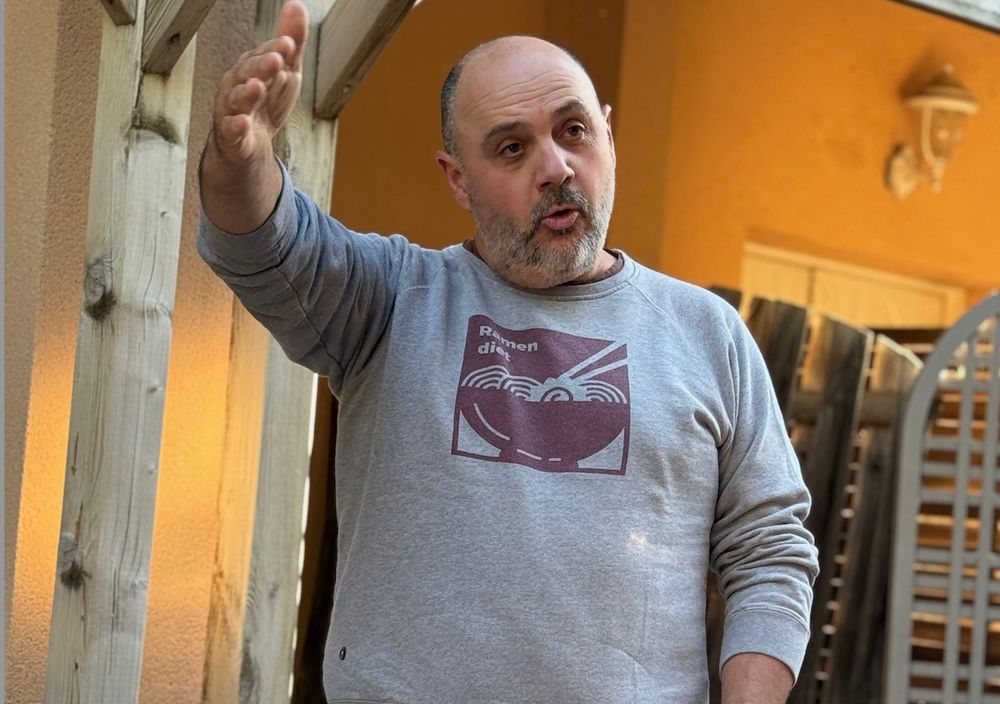
Sylvain Morey says the freedom to make wines you want offers so many opportunities for ambtious winemakers
Morey said he also likes the collaborative spirit in Luberon: “When we meet we learning something new from other winemakers. We are all still experimenting.”
What producers are experimenting with also depends which side of the mountain range of Luberon they are in, said Jeremiah Sennevile at the 26 hectare Mas Edem estate with sits in northern Luberon, which is more influenced by the Rhône, with its limestone and clay soils, compared to the sandy soils of the south which is more influenced by Provence.

Ian Wharton with Thomas Montagne, owner of Château de Clapier,
Thomas Montagne, owner of Château de Clapier, for example, can claim to be the only producer making wines from Pinot Noir in the region as part of his 87 acre estate. He took over the estate in 1995, becoming the fourth generation winemaker on a property that dates back to 1880.
Blended wines
The fact its AOC wines need to be a blend of multiple varieties is a good thing for producers, argues Dol, particularly with climate change and the ability it gives them to trial and test new varieties - with Greek and other Mediterranean varieties now under consideration in the region.
“We are still talking about our identity and what we can develop. I am going to plan some Grenache Gris, for example, and see what happens.”
It’s also what makes its wines so diverse, said Hervé Lasserre, director general of Château Val Joanis: “It’s hard to define a Luberon wine as we have so many different styles.”
Morey likens it to a “freedom” to make the wines you want and that match their sense of place. “We are not a cheap appellation. We are much more about quality, acidity, ripeness and good balance.”
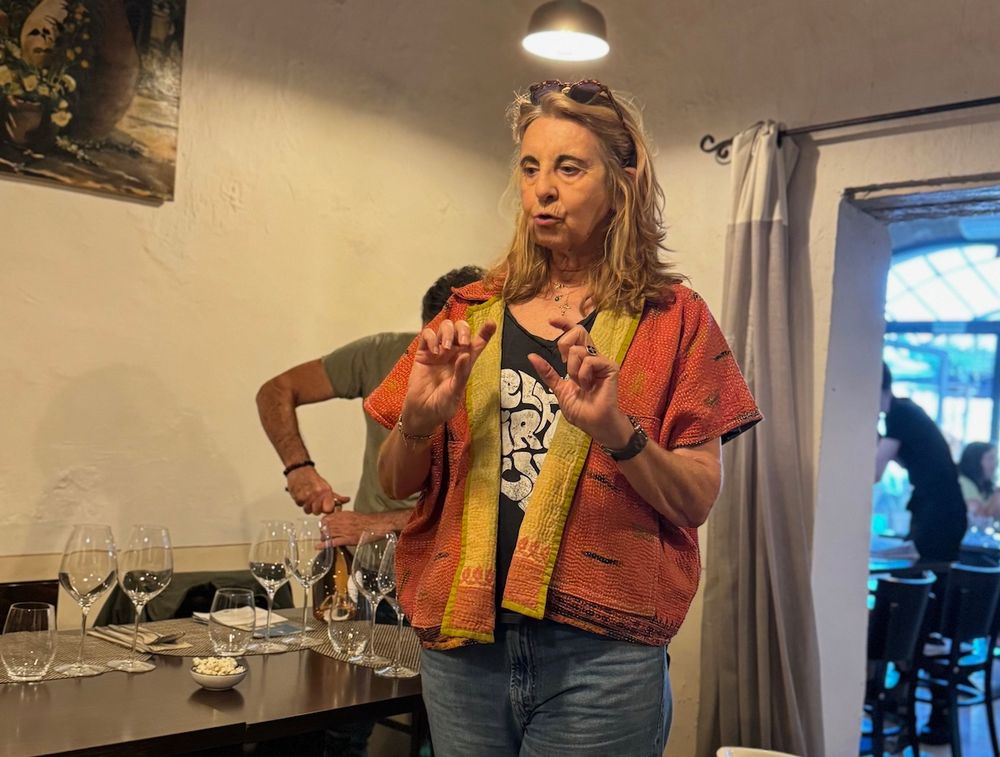
Anne Marie Bagnis of Château Constantin is excited about the quality of wine being made in Luberon
“The quality of our white wines is amazing now,” said Anne Marie Bagnis thanks to the red clay, limestone and rolled pebbles that help bring freshness and complexity to the 20 hectare organic Château Constantin in the village of Lourmarin she bought in 2016 with her husband, Daniel.
Vincent Brémond, of the organic 12 hectare Mont Thabor Vineyard, is also working well with its white blends and believes Luberon’s climate is well suited to producing fresh, vibrant, aromatic white wines - particularly using Vermentino in the blend.
Laurie Besnier, winemaker at Domaine de MasLauris, agrees: “The Luberon is a good place to make rosé, but the chance to make white wines is even better.”
Setting the pace
Whilst a growing number of producers are switching strategy to produce and make their own wines the majority of production still goes through the main co-operatives of which Marrenon is by far the biggest - a union made up of 385 growers, or what Marrenon prefers to call ‘vignerons', that is responsible for 60% of the region’s total production. With wines coming from vineyards covering 4,000 hectares with two wineries in the north and four in southern Luberon.
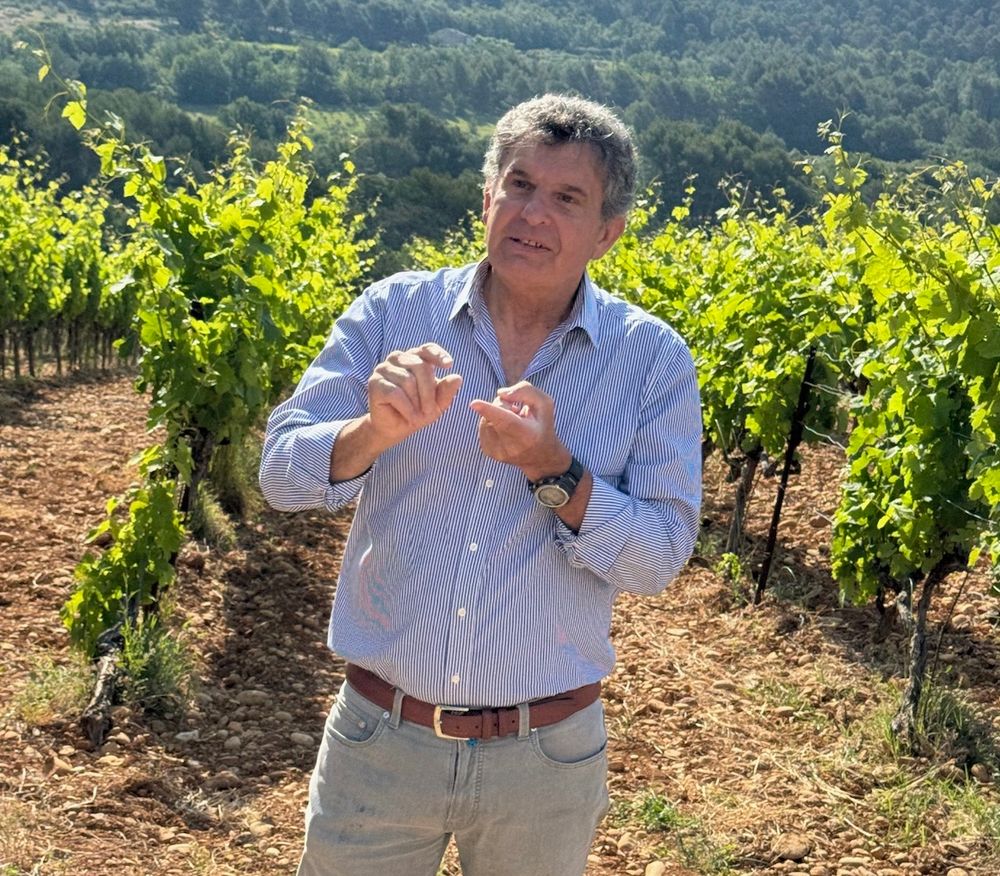
“We have in our mind the map of Luberon," says Philippe Tolleret, chief executive of Marrenon by far the biggest co-operative in Luberon
A union of growers, made up six separate co-operatives, that also abide by the same grape growing and sustainability procedures and agreements, ensuring quality and consistency across all the vines it is in control of, explained chief executive, Philippe Tolleret.
Its wines are made from blends taking the best fruit from both north and south of the region.
It is perfectly placed to see the big step changes taking place right across the region. “We have in our mind the map of Luberon,” added Tolleret. “We want to have a style of wine from Luberon that winemakers want to make and the market will like.”
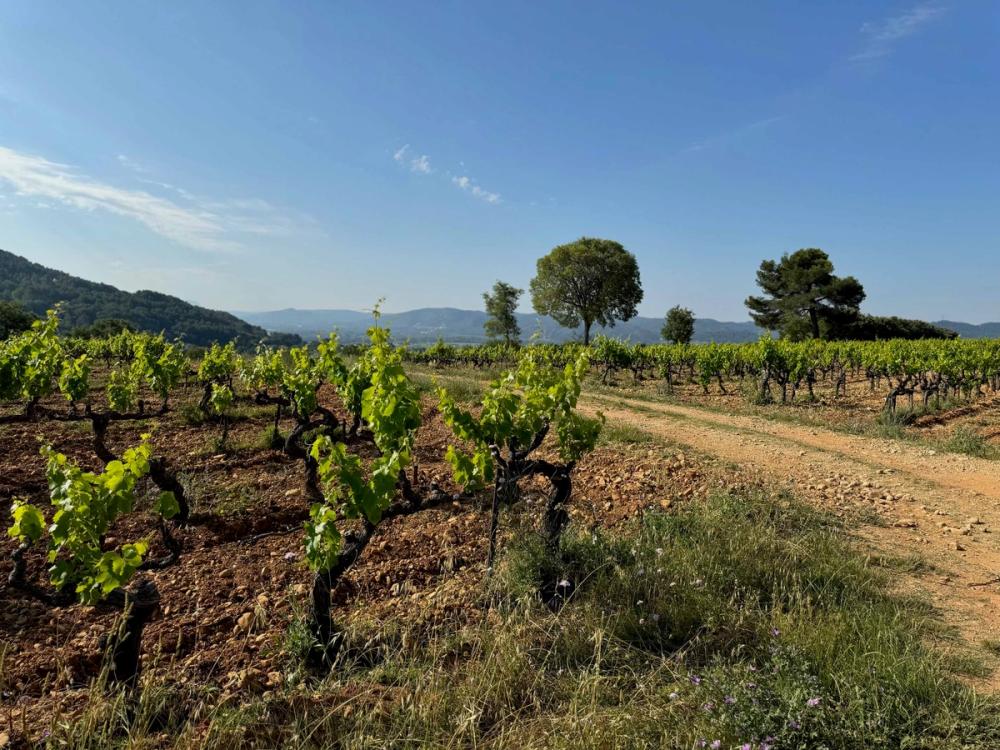
Marrenon is also helping to shape Luberon’s overall strategy with its own big focus on white wines. “The market has been asking for more white wines over the last five years. Wines with freshness, crispiness, which is why we are asking our members to grow more Vermentino,” he said. “We want to make accessible wines.”
“We want to get across that our big difference is the freshness and easiness of our wines,” said export manager, David Quinones, whilst also recognising the climatic, terroir and style differences there are between the north and south of the region.
He added: “The Luberon has so many stories to tell, but it is good that over the last 10 to 15 years we have all started to tell the same one.”
It’s also why Marrenon is selling its wines in 45 countries around the world and has set up a network of 50 ambassadors across its members responsible for helping to share Luberon’s story. Around 80 of its members are responsible for 70% of its production, stressed Tolleret.
Investment

The buyers taking part in a tasting at the impressive and very personal winery of film diredtor, Ridley Scott as Mas des Infermières in northern Luberon
Perhaps it is the region’s relatively under the radar status that has also made it such a hot spot for major international investment in its wineries and estates. Like Hollywood director, Ridley Scott and his highly impressive Mas des Infermières estate in northern Luberon, where every detail is as nuanced and thought out as a scene from one of his classic films.
Although he has lived and grown grapes in the region for over 30 years, largely from his Grenache and Syrah vineyards, it is only since 2020 that he has started to make his own wines under the Mas des Infermières brand and not send his grapes to the local co-operative.
Here the focus is on HVE and Bee Friendly wines that have played an integral part in the major replanting and biodiversity programme that has taken the estate up to 30 hectares of vines - many of which have beehives in them.
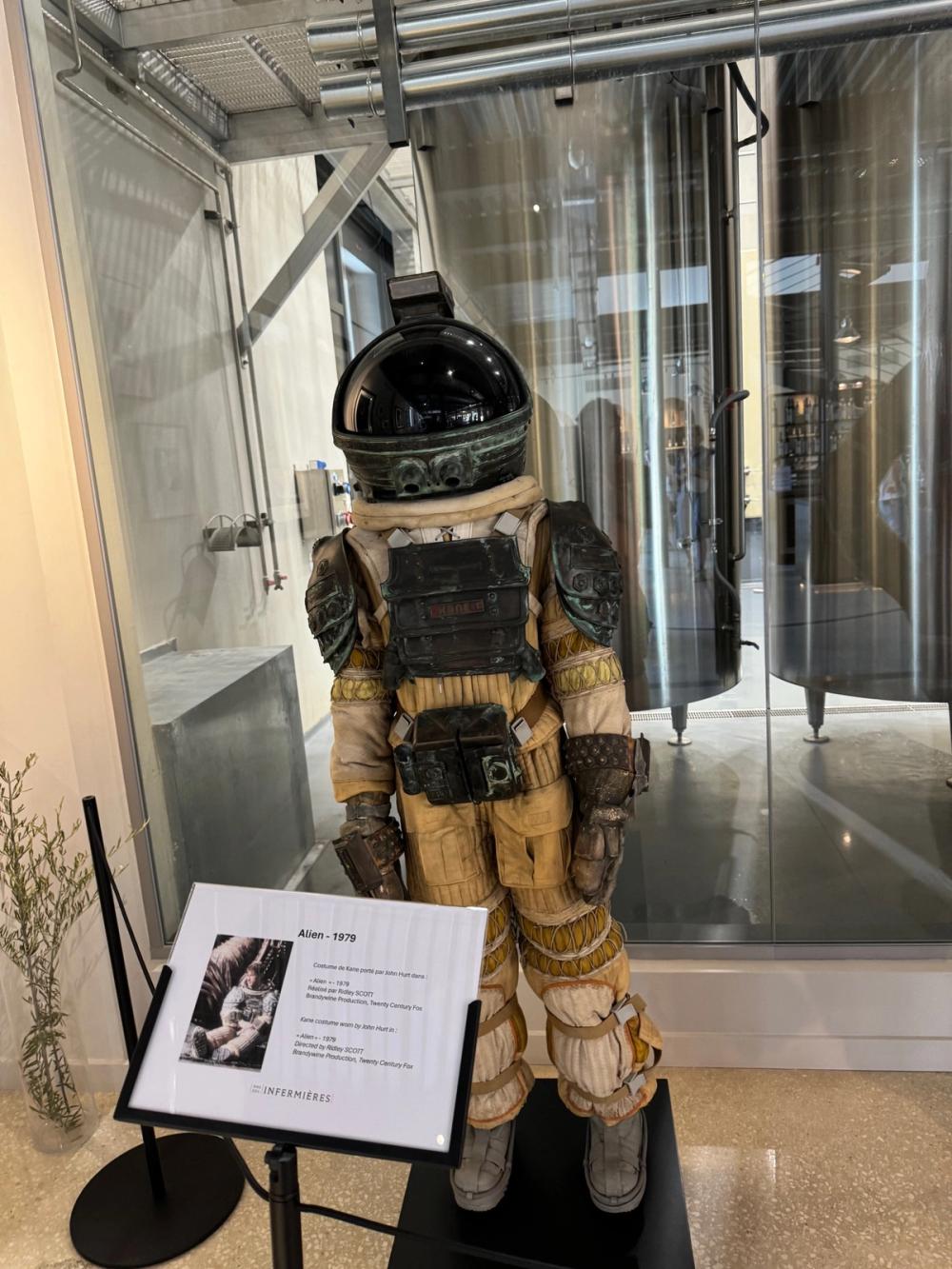
Ridley Scott has included a number of iconic costumes and pieces from the sets of his iconic films - like here from Alien at Mas des Infermières
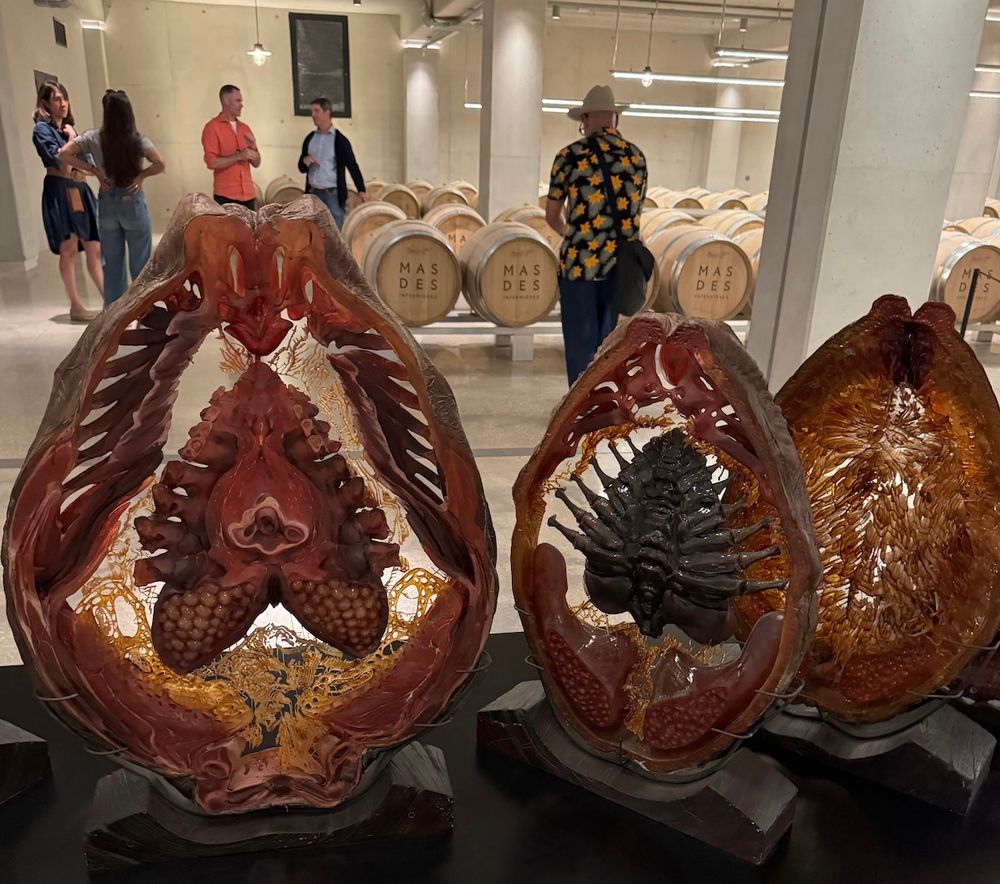
It produces a high end selection of fresh, fruity, balanced whites, reds and rosé wines using concrete for red wine ageing and stainless steel for whites. With a bee sticker proudly displayed on all the immaculately hand drawn Ridley Scott-designed labels. It is now producing around 100,000 bottles a year.
“It is very important for him to be only matched and associated with something that is high quality. To make the right decisions to make the best wines from the best parcels of grapes,” said sales manager, Mélanie de Rudder. “To only put in the bottle the best quality wine possible.”

Château de Sannes has vines dating back 100 years at its highly impressive and glamorous estate
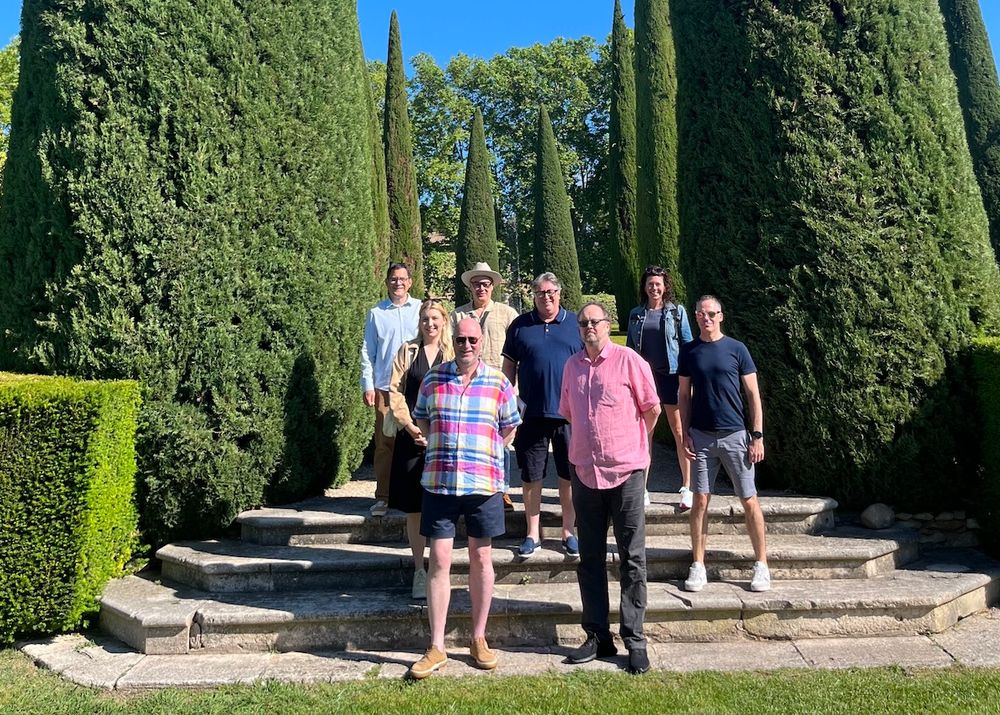
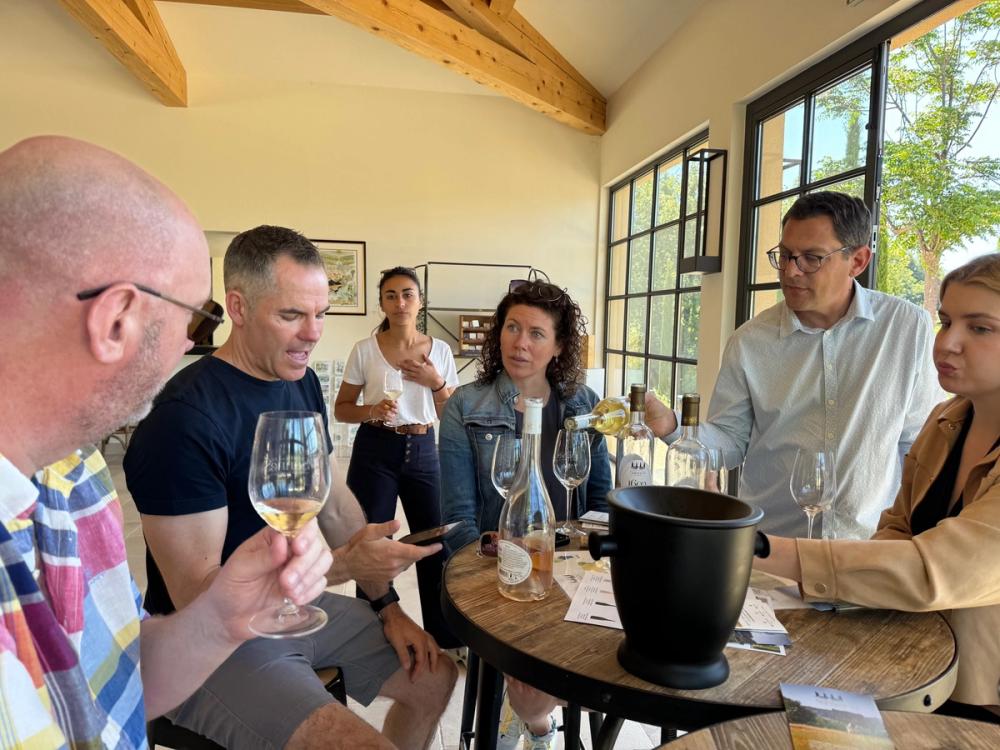
The buyers discussing the wines at Château de Sannes
Château de Sannes in the southern Luberon, previously owned by the Hamlyn publishing family, was taken over by French businessman, Pierre Gattaz, in 2017 and provides a Hollywood level of glamour and scale with its manicured gardens and an estate, complete with its own 17th century château, that could have come out of the Great Gatsby. It has vines dating back 100 years amongst the 34 hectares of vines on the property and is able to ferment and isolate all its different parcels in order to make both complex and appealing wines to drink. Its planted four hectares of Vermentino, for example, in order to give its wines that freshness and vibrancy it is looking for.
Constance and Lawrence Slaughter can lay claim to have bought, in 2018, the oldest wine estate in the region - Château de Mille in northern Luberon - that dates back to 1238 and it now makes wine from a selection of old vines including Grenache (70 years old), Syrah (50 years old), Carignan (60 years old) and Ugni Blanc (50 years). It has 25 hectares of vines out of 116 on the property and has looked “to change the direction” of the estate towards producing around 50,000 bottles a year of quality, organic wines.
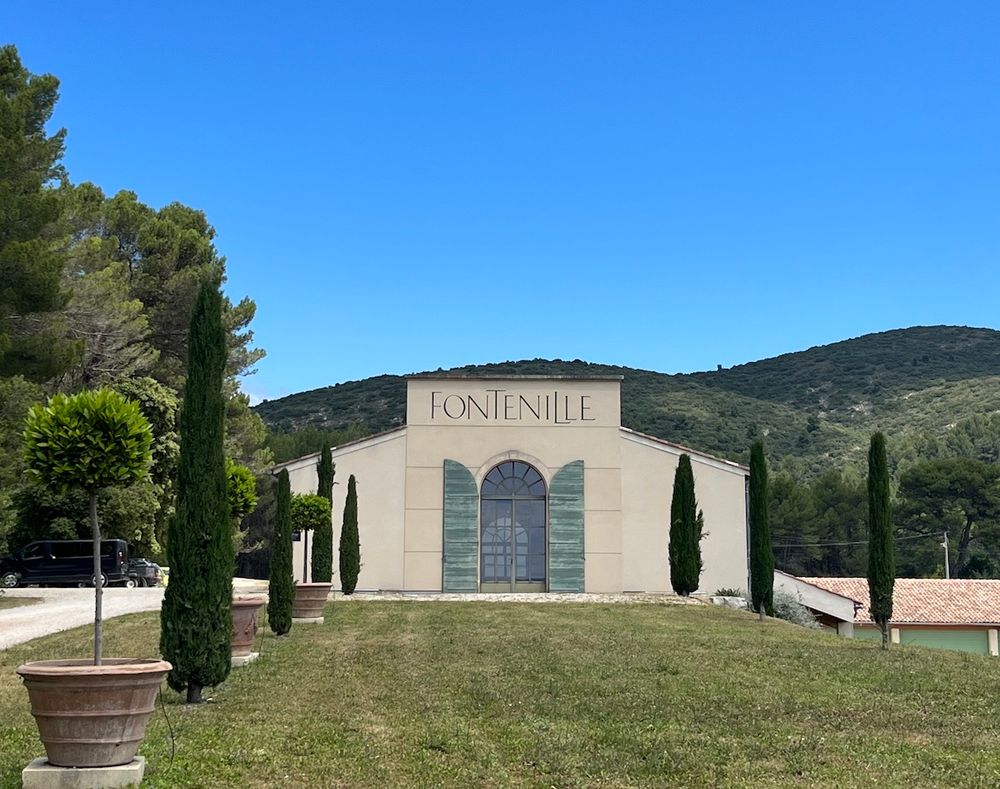
Domaine de Fontenille is a good example of the level of investment in Luberon with a premium hotel attached to the state of the art winery
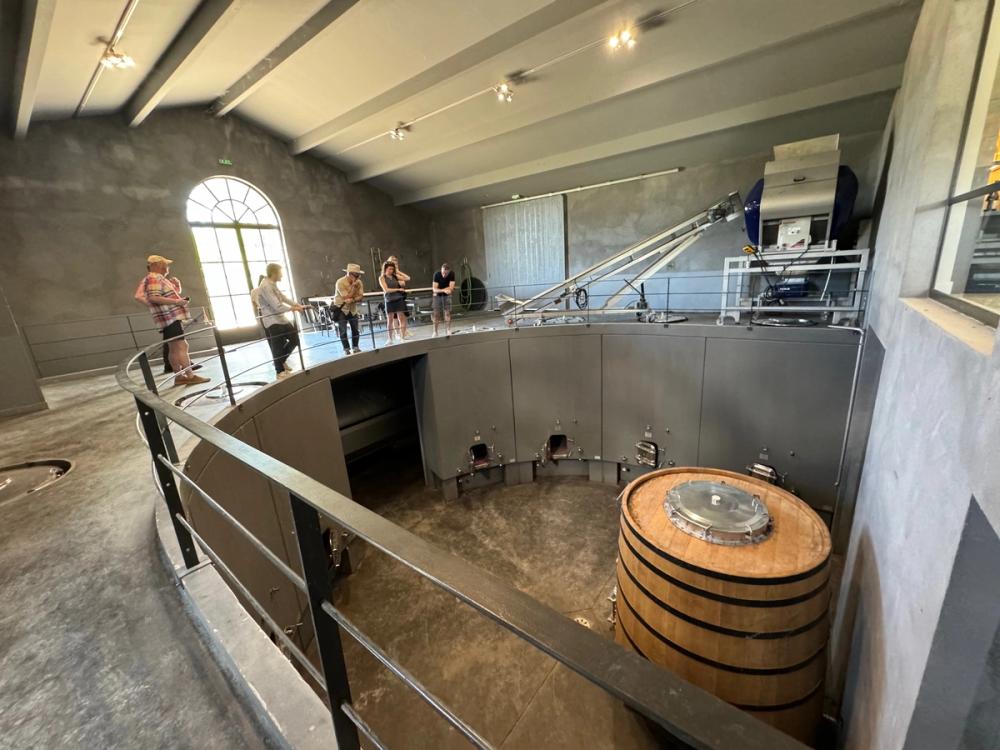

Domaine de Fontenille is of a similar scale and ambition with a history that dates back to 1638. The 42 hectare estate and winery was bought in 2013 and is part of the Domaine de Fontenille international hotel group. It built its own gravity driven bespoke winery two years ago in order to capture both traditional and modern organic winemaking and is now producing around 250,000 bottles a year. It does not have a current UK partner.
“The Luberon is changing its image and the quality is so much higher now here thanks to both the private investment, independent producers and the co-operatives,” said Wendy Gobbi, who together with her husband Jean-Marc, were able to take over the historic Château Saint-Pierre de Mejans, complete with its 11th century priory and Roman chapel, in 2021 thanks to the success of its international schools business.
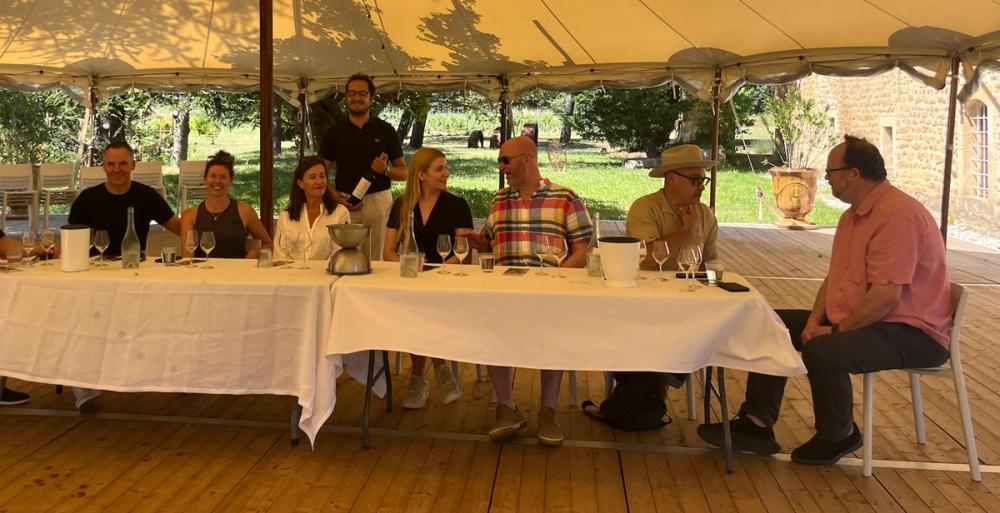
The group of buyers enjoying an al fresco tasting at the highly impressive Château Saint-Pierre de Mejans
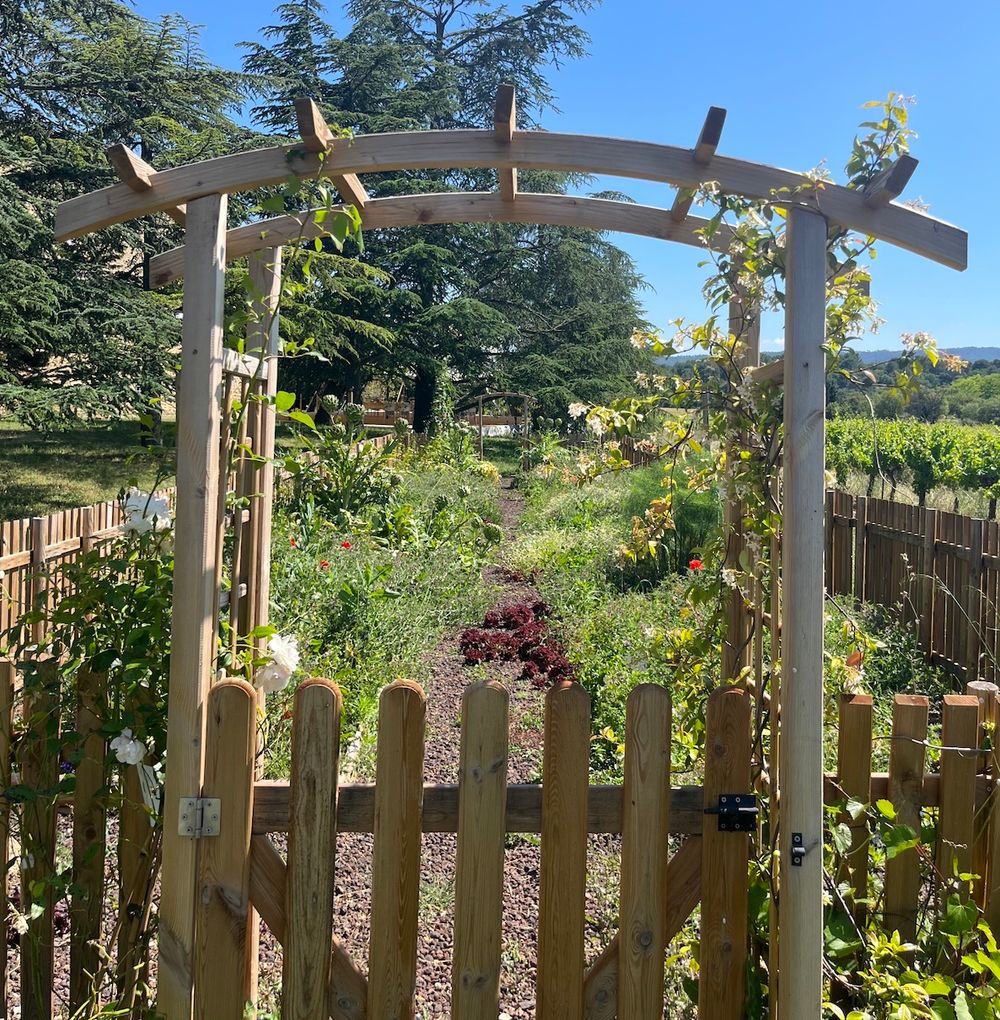
Promoting biodiversity is a key part of Château Saint-Pierre de Mejans and other producers across Luberon
A major renovation and investment programme has transformed the estate, which has been making wine since the 12th century, and it too now is producing rather than selling its grapes and has opened up the historic site to tourists and runs its own boutique hotel. It also has its own beehives to help with its extensive biodiversity programme.
Being able to offer a wide range of tourist services on top of making wine has to be the way forward, she added. “It is a very challenging and a lot of hard work making wine and it is a long process planting and converting to organics. But we want to make more specific and gastronomic wines.”
Domaine de la Citadelle is another northern Luberon estate with new owners, Valérie and Yannick Panagiotis that took over the property in 2022. They are looking to take its organic winemaking in a new direction and using different ageing formats, including amphora and concrete eggs, to make better quality wines, said estate manager, Geneviève Bauve. It is also looking to plant different varieties amongst its 40 hectares of vines (aged between 15 and 75 years), including Cabernet Sauvignon, that can cope with its unique climate and soils. It is producing around 160,000 bottles a year, with 50% red, 30% white and 20% rosé.

Organics and using different formats for ageing is a key part of La Citadelle's offer
What makes their investment so welcome is they all share a common goal to raise the overall profile and quality of Luberon wine, rather than be shining lights on their own.
Virginie and Jean Marc Mercier gave up their respective careers in the food industry and banking to take over Château La Sable, one of the first independent producers in the region with vines dating back to 1967, in 2017. They have been busy restoring the estate in southern Luberon since and replanting it with new varieties including Rolle/ Vermentino, Clairette, Syrah and Grenache and converting its wines to organic production. It is now producing around 25,000 bottles a year with the capacity to grow to 65,000.

Virginie Mercier and her husband Jean Marc have given up big corporate careers to make wine in the Luberon at Château La Sable
They both admit to still feeling liking “beginners” but also feel liberated to trust their own judgements as there are “no right decisions” when it comes to making wine. “You have to be making decisions sometimes 24 hours a day. But every decision is for the long term. It is still very exciting to see our grapes growing,” said Virginie Mercier.
Buyers' perceptions
The buyers were happy to admit they went on the trip with their perceptions wide open to what they might find.
Enotria’s John Graves, how had not visited the region before, said he “knew it was a satellite of the Rhône” and was “expecting big reds and flabby whites and some nice AirBnB properties”.
His understanding having visited the area had “100% changed for the better”.
He was particularly taken by “the Gigondas-style there was in many of the red wines”. Wines that offered so much more quality than the equivalent price for an actual Gigondas wine.
“Nothing feels forced,” he added. “The work is being done in the vineyards and not the cellars.”
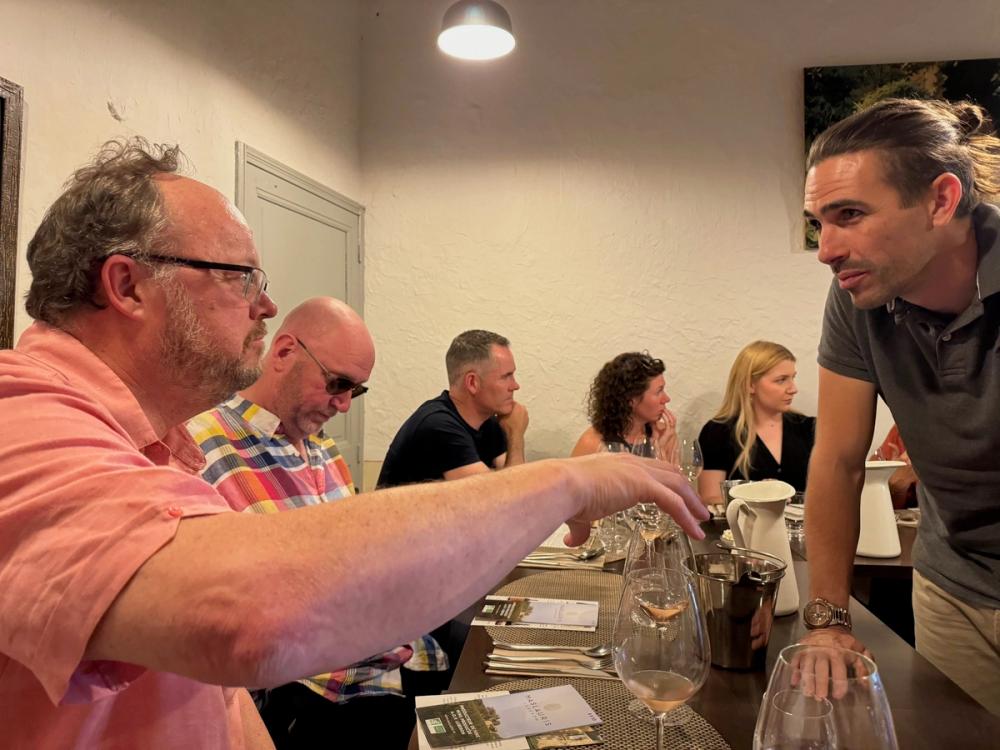
Enotria's John Graves says he his perception of the Luberon has changed "100% for the better" being on the trip
He said it was good to see the producers mostly speaking with one voice as to cut through in the UK it needs to “create a Luberon massive - don’t try and be individuals”.
He added: “Ridley Scott’s wines at Mas des Infermières are good to hang a hat on. The co-operative guys at Marrenon know what they are doing and they can give a critical mass. They just need to get more people out there. It’s really been an eye opener.”
Danny Spencer added: “What a fabulous trip. I’ve been doing this for 30 years now and to meet new people and in effect visit a new region is such a joy.
He too had been expecting to taste a lot of big, powerful red wines: “I think we were pretty much in agreement that we thought we were in for some big, hot climate Grenache and Syrah, how wrong we were, so that in itself is a positive for the region in itself.”
What particularly impressed him was how consistent the wines were, particularly in how they are “designed for the 21st century and a changing wine demographic”.
“They were a breath of fresh air in the main.”
Spencer felt the white wines were the most successful, followed by the rosés and then the reds. The whites, in particular, stood out as the Luberon is surrounded by two regions where whites are so hard to find.
“All of them are lifted and in Rolle / Vermentino they almost have their own grape variety, certainly in the sort of volumes they have. Picpoul de Pinet has become ubiquitous, there always has to be the new kid on the block, why not Luberon Blanc?”

Danny Spencer came away highly impressed by the quality and diversity of wines on offer
He added: “The rosé can offer a point of difference at a good price from all the dull and boring Provence rosé out there, but they have to be around the same price as good Provence, they have to prove that they are punching above their weight. And personally I really enjoyed a lot of the reds. Fresh, perfumed, elegant, restrained, not what I was expecting at all. I thought it was going to be like Bandol and was very happily surprised.”
He also agreed with Graves that the region needs to speak with one voice - particularly between the big co-operatives and larger independent producers.
He explained: “It is a tiny AOC and they can only thrive in export markets with a united voice. Marrenon, the union, controls 60% of total production and makes some bloody good wines which are well packaged and no doubt fabulously priced. They can open the door to grocers etc and people who see it in Waitrose and M&S may well be tempted by something more exotic at say the Oxford Wine Company, as will diners in quality pubs and restaurants. That way everybody wins. And as John says, having Ridley Scott in such a tiny AOC can only be a massive boost.”
Katy Barker said she felt like one of her customers at Oxford Wine Company discovering a region for the first time. “Younger people are looking for wine countries and regions that are investing in forward thinking winemaking, that are organic and low intervention. They are looking for light, fruit forward wines - which is what we have found here,” she added.
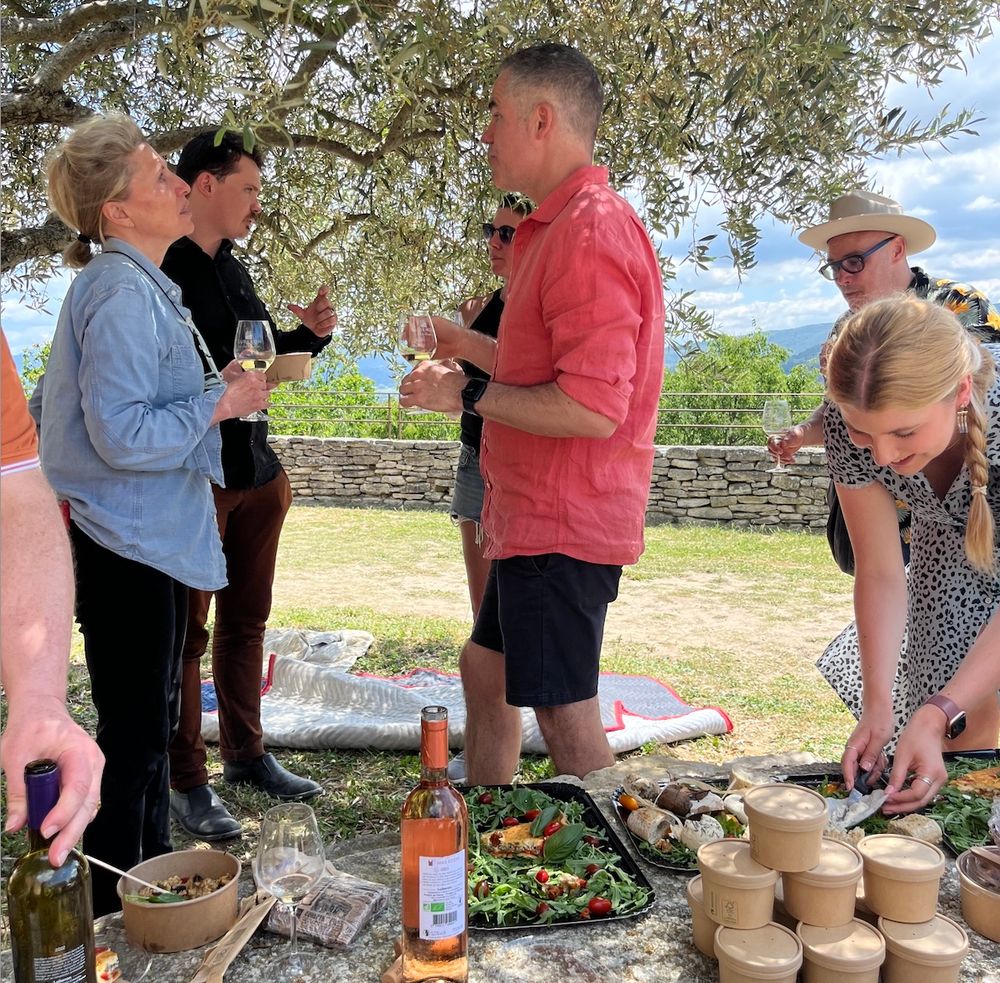
Ian Wharton talking to Constance Slaughter of Chateau de Mille
Ian Wharton said he liked the fact there are “not a lot of well known producers - it draws people in”.
Whilst impressed by all the styles of wine she tasted, both Heath Ball and Juliet Doughty felt “the whites and rosés have outshone the reds”. “I found more whites than reds that I would like to sell,” added Doughty.
“That’s the beauty of Luberon. It’s so diverse and versatile. We love that diversity,” added Doughty.
Graves said the requirement to blend was definitely to the Luberon’s advantage. "It means there are lots of styles and different wines in a small area. It’s really good to see.”
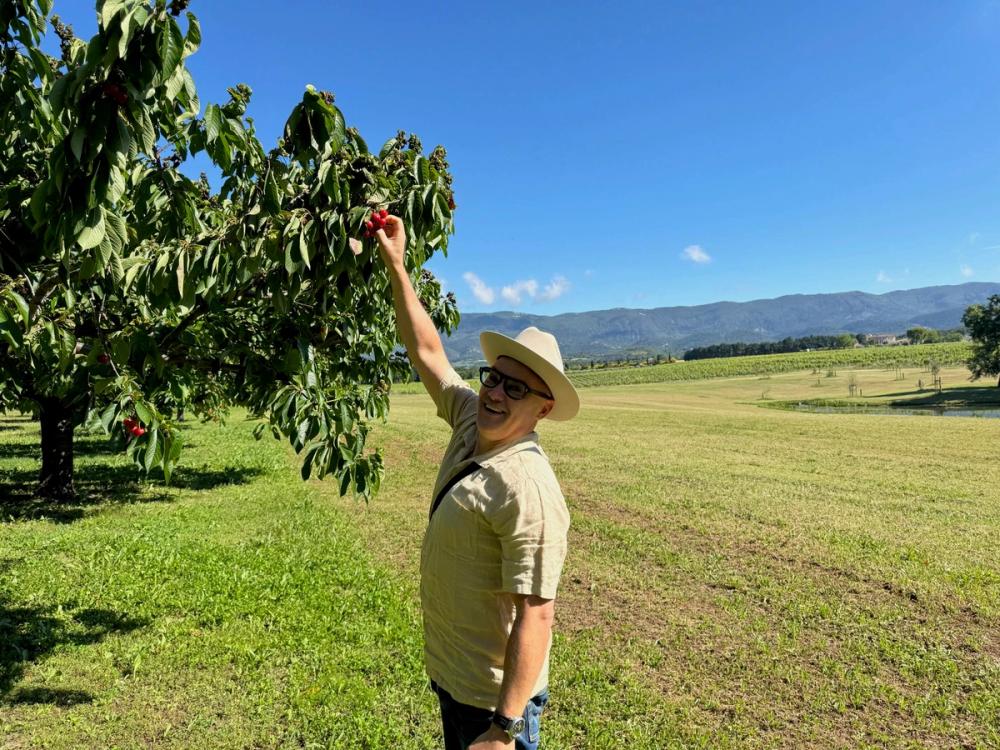
Heath Ball was particularly impressed by the white wines
The Luberon’s focus on developing its white wines got the thumbs up from the buyers.
Doughty said: “Some of the white wines we have tasted I would compare to serious whites regions in France - like Burgundy.”
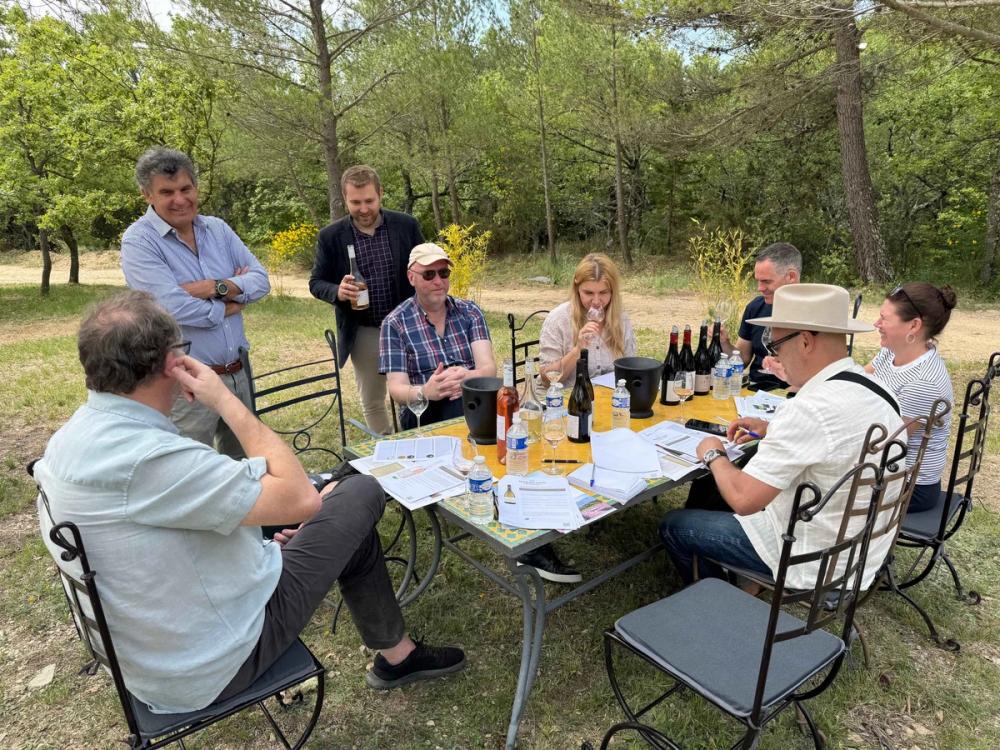
The group getting down to the business of tasting with the Marrenon team
Ball agreed: “The whites are the sweet spot for Luberon. They are really exceptional.”
That said the buyers were also highly impressed by the quality, but also gastronomic level of Luberon’s rosé wines.
“There are some serious rosé wines being made here. We need more people in the UK to take rosé as seriously like this,” said Graves. Again it is the diversity of styles of rosé that is so appealing, added Doughty.
Pricing
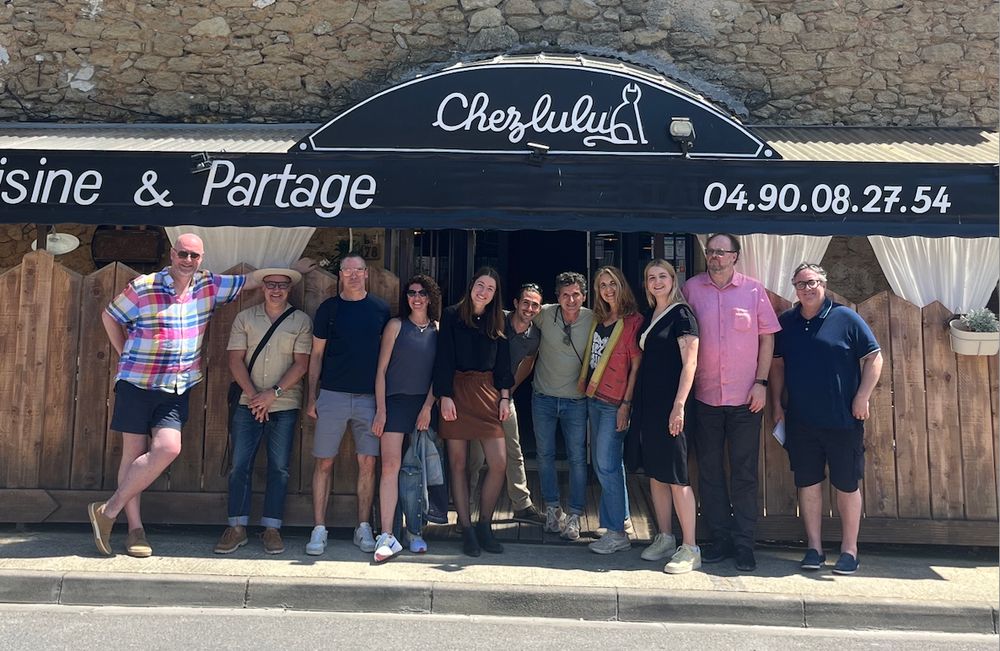
The panel of buyers were able to enjoy the Luberon lifestyle of eating, drinking and enjoying the company of many of its winemakers
Whilst the panel of buyers had no doubt about the overall quality of the wines, there were concerns they may not achieve their full potential in the UK unless there was a movement on price, particularly in terms of getting initial listings.
Graves felt the pricing of some of the more premium wines were better suited for an independent wine merchant and the retail channel than they would be for the ultra competitive on-trade where the knock-on price from the distributor to the final wine list price might be too prohibitive.
To work in the on-trade it would be need to be around £10 into the trade and £50 or less on a restaurant list.
“I think it’s all about price point,” he stressed. “For me the simpler wines have the best potential. They have exactly the right flavour profile for the UK market. Lighter, fruity reds with structure, drier whites with good acidity, but with nice aromatics. Wines with Vermentino and Clairette seem to be the ones I liked best.”
Spencer said the big question a buyer has to ask is “where can we find a space for this wine where it can find its way in the market”.
He explained: “For the reds they really need to be in and around single estate Gigondas, Rasteau etc prices. The co-operative, Marrenon, also makes Ventoux so it knows where it needs to be. The whites were the revelation but the consumer generally expects to spend less on whites. If they are to be the next Picpoul de Pinet they still need to be around, or not much higher, than that of Muscadet, Vouvray, Gruner, Gavi etc.”
He agreed with Graves that for its wines to work in the on-trade he needs to be able to sell into the UK trade at around £10 so that it can “hits lists at between £40 and £50”.
* In part two of our report we talk to some of the buyers in depth about what they thought of the trip, the Luberon wine region and the wines they tasted.
